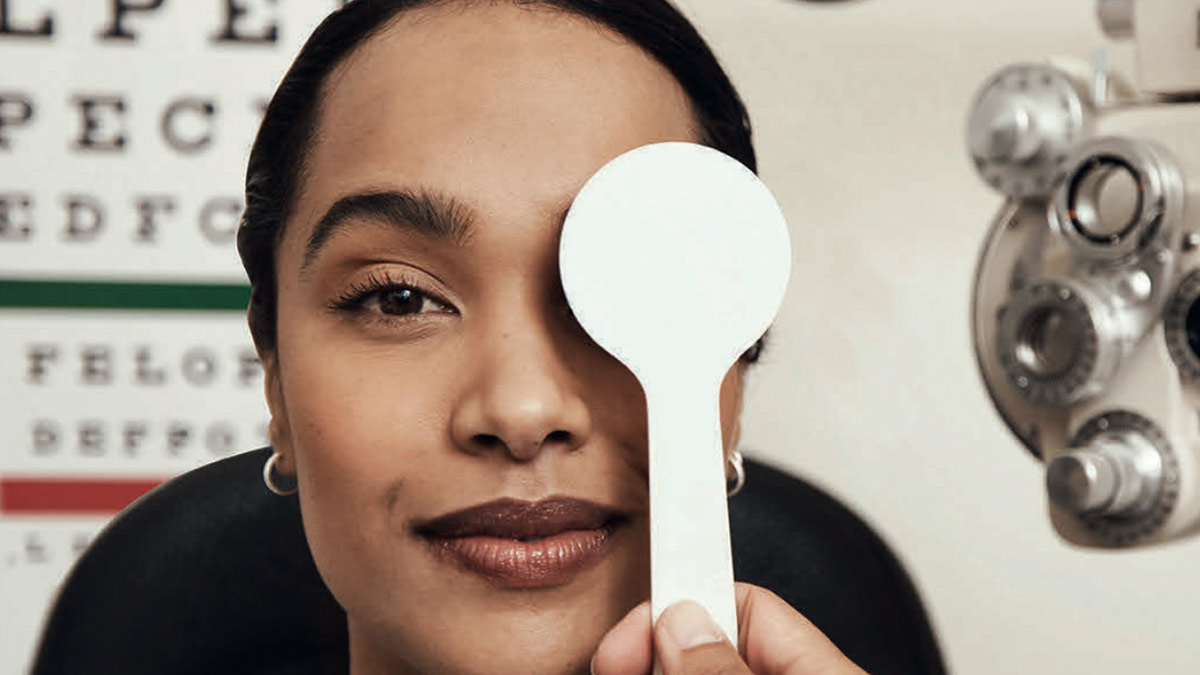Damien O’Brien MPSI provides a synopsis of some common eye conditions, as well as treatment opportunities
Introduction
The human eye is the organ of the sensory nervous system that reacts to light and allows use of visual information for various purposes including sight, balance, and circadian rhythm. There are many different components that are vital in the structure and function of the eye. The sclera and choroid are outer layers of the eye that are important in ensuring light only enters via the eye’s optic axis. The cornea helps to focus light into the eye. The iris (coloured part of the eye) works together with the pupil (dark hole in the middle) to control the amount of light reaching the back of the eye. The lens focuses light on the back of the eye, while the retina, at the back of the eye, is important in processing images. The optic nerve carries information from the retina to the brain. Other components of the eye are important for protection, nourishment, lubrication, and maintaining shape. Eyecare encompasses a wide range of conditions, from common problems including dry eyes and conjunctivitis, to more serious conditions such as glaucoma and age-related macular degeneration (AMD).1
Good eyecare practices
There are several non-pharmacological methods that can improve care of the eye. Undergoing regular eye examinations is an important measure. This can provide information on the need for glasses or a change in prescription, as well as helping in the early detection of many eye conditions. The use of protective eye wear plays an important role, encompassing both the use of adequate sunglasses to protect against ultraviolet light and the use of protective eyewear when playing certain sports, working with chemicals, or other activities. Adequate lighting is essential to reduce eye strain and fatigue, particularly when performing tasks such as reading or using a computer. Managing screen time, including taking regular breaks, reduces the risk of developing eye strain due to digital screen use.2
Nutrition is integral in the maintenance of eye health and can be achieved through dietary intake or supplementation if necessary. Vitamin A, C, and E have antioxidant properties that may be protective for both the lens and the retina. Selenium is a mineral that can play a role due to its antioxidative properties. Zinc has a role in retinal metabolism and, as a result, may be beneficial in macular degeneration. Gamma-linolenic acid (GLA) is an essential fatty acid that may help in dry eye conditions, while Omega-3 fatty acids are important in retinal development.3 Lutein and zeaxanthin are carotenoids that accumulate in the retina, specifically in the macula. A high serum level of these carotenoids has been shown to have a beneficial effect in delaying the progression of eye conditions such as AMD and cataracts.4 Furthermore, smoking cessation can also improve eye health, as smoking increases the likelihood of developing conditions such as AMD, cataracts, and optical nerve damage. Finally, ensuring adequate hydration is essential for maintaining moisture levels in the eyes, reducing irritation and supporting overall eye health.2
Overview of eye conditions
There are several common eye conditions that can cause pain and irritation, impair vision, and lead to a reduced quality of life. Early diagnosis and treatment can help to improve clinical outcomes for patients and lead to improved eye health.
Dry eye syndrome is a multifactorial condition of the ocular surface characterised by a loss of homeostasis of the tear film. It is caused by poor tear quality or insufficient tear production, which results in dry, irritated, or itchy eyes. There are several potential causes associated with dry eyes and these include certain medication use, ophthalmic surgery, allergies, decreased androgen levels, computer use, autoimmune conditions, smoke, pollution, and weather conditions. There’s no gold standard for diagnosis of dry eye but an evaluation of signs and symptoms is usually sufficient. Management of the condition often depends on the severity of the disease and is performed in a stepwise approach. Initial management involves patient education, modifying the environment, and avoiding triggers. Lubricating eye drops – containing an ingredient such as carbomer, hydroxypropyl methylcellulose, sodium hyaluronate, or carmellose sodium – are commonly used to relieve dryness and discomfort. Preservative-free ocular lubricants, moisture goggles or ocular anti-inflammatory medications, such as cyclosporine, may be used if other treatment options have failed.5
Conjunctivitis is a common eye condition characterised by inflammation of the conjunctival tissue and it presents with symptoms that include ocular redness, pain, and discharge. Conjunctivitis can be classified as infectious or non-infectious. Infectious conjunctivitis can result from bacteria, viruses, fungi, and parasites. Viral conjunctivitis accounts for the majority of acute cases, with adenoviruses responsible for most of the viral cases. Other common viral pathogens are herpes simplex, herpes zoster, and enterovirus.
Bacterial conjunctivitis is the next most common cause of conjunctivitis, with Staphylococcus aureus, Haemophilus influenza, Streptococcus pneumoniae, Neisseria gonorrhoeae and Chlamydia trachomatis common bacterial pathogens. Allergens, toxins, and local irritants are generally the cause for non-infectious conjunctivitis. Diagnosis is generally based on patient history and a physical examination in order to identify the underlying pathology and determine appropriate treatment. Laboratory and culture tests are rarely used, unless it is for recurrent conjunctivitis, treatment-resistant conjunctivitis, or suspected gonococcal/chlamydial infection. Imaging studies generally do not play an important role in the diagnosis of conjunctivitis unless an underlying pathology is suspected.6
Patient education on hygiene measures is important to reduce the spread of infection. Bacterial conjunctivitis is generally self-limiting, but treatment can reduce duration of symptoms. Antibiotic eyedrops are used to treat bacterial conjunctivitis, with fusidic acid, ofloxacin, chloramphenicol, and azithromycin often used. Associated chlamydia or gonorrhoea infection should be appropriately treated with antibiotics, such as ceftriaxone or azithromycin. Viral conjunctivitis due to adenoviruses is generally self-limiting, with treatment objectives targeting symptomatic relief with cold compresses and ophthalmic lubricants. Ophthalmic antivirals, including aciclovir and ganciclovir, may be used if necessary. Oral antivirals, such as famciclovir and valaciclovir, may also be considered as treatment options in severe cases. Allergic conjunctivitis should be management by avoiding allergens. Topical antihistamines or topical mast cell inhibitors are also effective in treating symptoms. Olopatadine and ketotifen are antihistamines eyedrops that are available on prescription, while sodium cromoglycate is a mast cell stabiliser that is available both over the counter (OTC) and on prescription. Oral antihistamines, including cetirizine, loratadine, bilastine, levocetirizine, and fexofenadine can be used to treat moderate-to-severe cases.6
Blepharitis is a common condition that is characterised by an inflammation of the eyelid. Symptoms are often recurrent, involve both eyes and include itching, burning, and crusting of the eyelids. It can be caused by bacteria, viruses, mites, or skin conditions such as rosacea. Diagnosis is based on history and examination. The main treatment is maintaining good eyelid hygiene and avoidance of triggers that exacerbate symptoms. Warm compresses may be applied to the eye. Ophthalmic antibiotics may also be effective as a treatment option. A short course of topical corticosteroids can be useful in patients with ocular inflammation.7
A cataract is a clouding of the normally clear lens of the eye, and it obscures the passing of light through the lens to the retina. It results in blurred vision, glare, and difficulty seeing in poor lighting. Cataracts are a significant cause of blindness. The condition can affect all age groups, but it predominately affects older people. It can vary in severity and usually progresses gradually to interfere with normal day-to-day activities and reduce quality of life. Treatment options include correction with refractive glasses when in the initial stages of the condition. Medical treatment with cyclopentolate or atropine may be useful, but surgery is the main treatment option if a cataract is adversely affecting eye health. Surgical removal involves removing the cloudy lens and replacing it with an artificial intraocular lens. The prognosis for cataract surgery is very good. Post-cataract surgery, patients should be initiated on topical corticosteroids and antibiotics. Dexamethasone and prednisolone are commonly used corticosteroids and should be administered in tapering doses. Patients should be monitored for complications. Lubricant eyedrops or cycloplegic eye drops, such as cyclopentolate and atropine, may be used as add-on therapy.8
Diabetic retinopathy is a complication of diagnosed or undiagnosed diabetes that affects the blood vessels in the retina and can lead to vision loss. Poor glycaemic control, uncontrolled hypertension, dyslipidaemia, nephropathy, and obesity are all associated with worsening diabetic retinopathy. Diabetic retinopathies are characterised by microaneurysms, hard exudates, macular oedema, and new blood vessels of the fundus. Prompt diagnosis and a management plan are important in achieving good clinical outcomes. The systemic control of diabetes should be optimised by strict metabolic control, maintaining haemoglobin A1C (HbA1C) levels under 7 per cent, healthy diet, and regular exercise. Intravitreal pharmacotherapy and laser photocoagulation are also treatment options. Anti–vascular endothelial growth factor (VEGF) agents may be administered as intravitreal injections and are first-line treatment for centre-involving diabetic macular oedema, with bevacizumab, ranibizumab, and aflibercept all potential treatment options. Laser treatment may be used as adjuvant therapy as photocoagulation can help prevent blood vessel leakage and vision loss.9
Glaucoma is an eye condition characterised by elevated intraocular pressure (IOP) that can progress to vision loss. It can be categorised into either primary or secondary glaucoma and then further into open-angle or closed-angle glaucoma, within primary or secondary. Secondary glaucoma differs from primary glaucoma as it often arises due to a previous eye injury or an underlying medical condition. Primary open-angle glaucoma is the most prevalent type of glaucoma. In glaucoma, the drainage of fluid through the trabecular meshwork is unregulated which leads to an increase in IOP. This elevated IOP leads to the loss of retinal ganglion cells and axons within the optic nerve and a progressive loss of vision.10
Diagnosis of glaucoma is not based on a single gold-standard test but includes tonometry, fundoscopic examination, visual field testing, and optical coherence tomography. Tonometry measures IOP and is therefore very important in diagnosing glaucoma. Management of glaucoma should be individualised based on the type and severity of the disease. Treatment options cannot reverse vision loss, but they aim to lower IOP with the objective of preventing further damage and vision loss. Medication classes that are used to treat glaucoma include prostaglandin analogues, beta-blockers, carbonic anhydrase inhibitors, and alpha agonists. Latanoprost, bimatoprost, and travoprost are examples of prostaglandin analogues that help reduce IOP, while dorzolamide and brinzolamide are carbonic anhydrase inhibitors that decrease IOP. Brimonidine and apraclonidine are alpha agonists that reduce IOP by decreasing fluid production and increasing fluid drainage. Timolol is a beta-blocker that helps to lower IOP. There are several combination products which can help improve compliance and clinical outcomes when compared to monotherapy.10
Age-related macular degeneration is a condition that affects the central part of the retina (the macula) and leads to central vision loss. AMD particularly affects older adults. Age is the primary risk factor associated with this condition, while smoking and female gender also thought to be risk factors. AMD can be classified into two categories – dry (non-neovascular) AMD and wet (neovascular) AMD. Various imaging techniques are often used in the diagnosis of AMD. Regular monitoring in the early stages of AMD is important to identify early signs of progression of the condition. Various nutritional supplements may have some effectiveness in slowing the progression of AMD. Intravitreal anti-VEGF injections, such as bevacizumab, ranibizumab, and aflibercept, are the main treatment option. They have been shown to slow progression of the disease, improve visual acuity, and improve quality of life. Laser photocoagulation, photodynamic therapy, and surgery are other potential, non-pharmacological treatment options.11
Role of the pharmacist
Pharmacists play an important role in eyecare and are involved in improving patient outcomes and overall health of the eyes. Pharmacists can educate patients on appropriate techniques for ophthalmic products, counsel on vitamins and minerals important for eye health, and suggest potential lifestyle modifications that may be appropriate. Pharmacists can also advise patients on the importance of medication adherence in eyecare. They can ensure patients receive appropriate treatment for their condition, avoid potential drug interactions, and monitor for adverse effects. Pharmacists can practise patient-centred care and contribute to improving the quality-of-life for patients with eye conditions.12
References upon request







